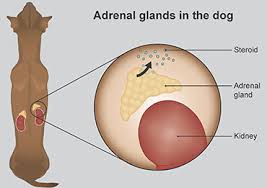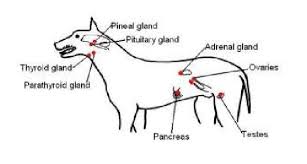
what is addison’s disease in dogs?
Addison’s disease in dogs, also known as canine hypoadrenocorticism, is a condition where the adrenal glands do not produce enough hormones, particularly cortisol and aldosterone. These hormones play an important role in regulating various bodily functions, such as metabolism, the body’s response to stress, and electrolyte balance.
Important hormones affected
Cortisol: Helps the body manage stress, regulate metabolism, and maintain immune function.
Aldosterone: Regulates sodium, potassium and water balance in the body, which is essential for blood pressure and hydration.
Reasons: Most commonly, Addison’s disease is caused by an autoimmune disease that damages the adrenal glands.
Less commonly, it can result from an infection, tumor, or injury to the adrenal gland, or from sudden withdrawal of steroid medication.

Common symptoms
- Lethargy or extreme tiredness
- Vomiting and diarrhea
- Loss of appetite and weight loss
- Weakness or tremors
- Increased thirst and urination
- Dehydration
- Depression or behavioral changes

What are the Early symptoms of addison’s disease in dogs
Addison’s disease in dogs, also known as canine hypoadrenocorticism, is a condition where the adrenal glands do not produce enough hormones, particularly cortisol and aldosterone. These hormones play an important role in regulating various bodily functions, such as metabolism, the body’s response to stress, and electrolyte balance.
Instruction points:
Here are the early signs of Addison’s disease in dogs, presented as guidelines:
- Monitor your dog for lethargy or unusual tiredness.
- Check for loss of appetite or refusal to eat.
- Observe if your dog vomits, whether mild or occasional.
- Watch for diarrhea, especially if it’s intermittent.
- Track any unexplained weight loss.
- Look for signs of muscle weakness or general weakness, especially after activity.
- Watch for any changes in behavior, such as depression or withdrawal.
- Beware of excessive thirst or excessive drinking.

What are the clinical signs of hypoadrenocorticism?
Clinical signs of hypoadrenocorticism (Addison’s disease) in dogs can vary widely and often mimic other conditions, making diagnosis difficult. Symptoms are primarily due to decreased levels of cortisol and aldosterone, which affect metabolism, stress response, and electrolyte balance. Clinical signs may be gradual or sudden (in the case of an Addisonian crisis)
Common clinical signs
- Lethargy – Dogs may be unusually tired, weak, or unwilling to engage in normal activities.
- Gastrointestinal problems:
- vomit
- Diarrhea (which may be intermittent)
- loss of appetite (anorexia)
- Weight loss due to reduced food intake and indigestion.
Increased thirst and urination – Dogs may drink more water than usual (polydipsia) and urinate more often (polyuria).
Dehydration – due to vomiting, diarrhea, and increased urination.
Weakness or collapse – especially after exercise or stressful events.
Tremors or muscle tremors – Muscle weakness and tremors may occur, often due to an imbalance in potassium levels.
Depression or behavioral changes – Dogs may seem withdrawn, disinterested, or generally depressed.
Slow heart rate (bradycardia) – often caused by abnormal levels of potassium in the blood.
Hypoglycemia – Low blood sugar can cause weakness, confusion, or even seizures in severe cases.
Abdominal Pain – Dogs may exhibit pain in their abdomen, sometimes leading to a misdiagnosis as gastroenteritis.
Low Body Temperature – Dogs may feel cold to the touch, especially during an Addisonian crisis.

Addisonian Crisis
In severe cases, a dog may enter an Addisonian crisis, a life-threatening emergency. Its symptoms include:
- fall suddenly
- Severe dehydration
- shock
- Yellow gums
- Low blood pressure (hypotension)
- Coma
An Addisonian crisis requires immediate veterinary intervention, which usually includes intravenous fluids and hormone replacement therapy to stabilize the dog.






